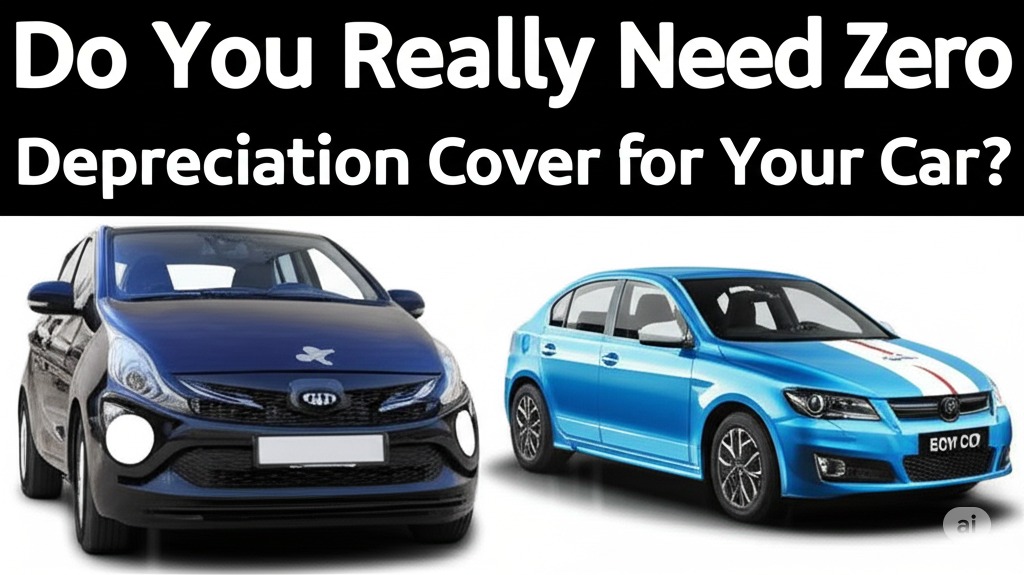Do You Really Need Zero Depreciation Cover for Your Car?
🚘 Introduction
Buying a car is one of the most exciting moments in life. But with ownership comes responsibility—including choosing the right car insurance. Among the many add-ons available in 2025, Zero Depreciation Cover stands out as one of the most recommended. But do you really need it?
If you’ve ever wondered whether it’s worth paying extra for this add-on, you’re in the right place. This detailed guide will break down what zero depreciation cover is, its benefits, drawbacks, and whether you should opt for it.
🛡️ What is Zero Depreciation Cover?
In standard car insurance policies, insurers apply a depreciation rate on car parts before settling claims. This means you never get the full cost of the replacement parts—you pay the difference.
A Zero Depreciation Cover (also called Nil Depreciation or Bumper-to-Bumper cover) ensures you get the full claim amount without any deduction for depreciation on the replaced parts.
📌 Example:
Without zero dep:
- Claim Amount: ₹50,000
- Insurer pays: ₹35,000 (after depreciation)
- You pay: ₹15,000 from pocket
With zero dep:
- Insurer pays: ₹50,000
- You pay: ₹0 (except mandatory deductibles)
⚙️ How Does Depreciation Work?
Every year, your car’s parts lose value due to wear and tear. This is called depreciation, and insurance companies factor it in when settling claims.
Standard Depreciation Rates (As per IRDAI – India):
| Car Part | Depreciation Rate |
|---|---|
| Nylon/plastic/rubber | 50% |
| Fiberglass | 30% |
| Metal parts | 0% to 50% (based on age) |
| Paint | 50% |
Older the vehicle, higher the depreciation. That’s why claims reduce as your car ages—unless you have zero dep cover.
✅ What Does Zero Depreciation Cover Include?
Zero depreciation policies generally cover:
- Full cost of plastic, rubber, fiber, and metal parts
- Full replacement value for damaged car parts
- Multiple claims during the policy year (some insurers limit to 2)
- Usually valid for cars up to 5 years old (some allow 7–10 years)
❌ What’s Not Covered Under Zero Depreciation?
Despite its benefits, zero dep cover doesn’t make your car insurance all-inclusive. It does NOT cover:
- Engine damage (unless you add engine protection cover)
- Mechanical breakdowns
- Wear and tear from regular usage
- Tyre damage (unless tyre protection is added)
- Uninsured accessories/modifications
💡 Add-ons like engine protect, roadside assistance, or return to invoice may be needed for complete peace of mind.
💰 Cost of Zero Depreciation Add-On
Adding zero dep to your policy will increase your premium by 10%–20% on average.
Sample Premium Comparison (for a new hatchback car in India):
| Cover Type | Annual Premium |
|---|---|
| Standard Comprehensive | ₹9,500 |
| With Zero Depreciation | ₹11,200 – ₹12,000 |
While it does increase costs slightly, the long-term savings on claims can outweigh the extra premium.
⚖️ Pros of Zero Depreciation Cover
1. Higher Claim Payouts
Get the full value of replaced parts without depreciation deductions.
2. Minimal Out-of-Pocket Expenses
You avoid paying for plastic, rubber, or fiber components during repairs.
3. Protects New Cars
A must-have for new or luxury vehicles, where parts are expensive.
4. Peace of Mind
Increases confidence while driving, knowing repairs won’t be a financial burden.
❌ Cons of Zero Depreciation Cover
1. Higher Premium
You pay more annually, which may not make sense for older vehicles.
2. Age Limit
Most insurers offer zero dep only for cars up to 5–7 years old.
3. Limited Claims
Some policies only allow 1–2 zero dep claims per year.
4. May Not Cover Engine/Accessories
Additional add-ons needed for full protection.
🧐 Do You Really Need Zero Depreciation Cover?
It depends on your car’s age, value, driving habits, and location. Let’s break it down.
✅ You NEED It If:
- Your car is less than 5 years old
- You own a premium/luxury vehicle
- You live in a city with heavy traffic or frequent accidents
- You’re a new/inexperienced driver
- You want higher resale value with minimal wear
❌ You Can SKIP It If:
- Your car is 8+ years old
- Your car has low market value
- You rarely drive
- You’re confident in paying small repair costs yourself
🔍 Real-Life Claim Comparison
Imagine your new sedan gets into a minor accident. The bumper, headlight, and fender are damaged. Here’s how the insurance claim would look:
| Item | Replacement Cost | Claim with Standard Policy | Claim with Zero Dep |
|---|---|---|---|
| Bumper (plastic) | ₹6,000 | ₹3,000 | ₹6,000 |
| Headlight (plastic) | ₹8,000 | ₹4,000 | ₹8,000 |
| Fender (metal) | ₹7,000 | ₹5,000 | ₹7,000 |
| Total | ₹21,000 | ₹12,000 | ₹21,000 |
Savings: ₹9,000 with zero dep cover on a single claim.
📆 How Long Should You Keep Zero Depreciation?
Most insurers allow zero dep cover for cars up to 5 years old. Here’s what you can consider:
- 0–3 years: Must-have for almost every car
- 4–5 years: Still recommended, especially for high-end cars
- 6–7 years: Check if your insurer allows, weigh cost vs benefit
- 8+ years: Usually not needed unless car is rare/collector type
📝 How to Add Zero Depreciation Cover
You can add zero depreciation when:
- Buying a new car
- Renewing your car insurance
- Switching insurers (portability allowed)
Ensure you:
- Compare quotes from multiple providers
- Read the policy wording and limits
- Ask about maximum claims allowed under zero dep
🔧 Other Useful Add-Ons to Consider
When opting for zero depreciation, also consider bundling with:
- Engine Protect
- Roadside Assistance
- Return to Invoice
- Consumables Cover
- No Claim Bonus Protector
These add-ons enhance your protection further—especially useful in cities prone to floods or theft.
✅ Final Verdict: Is Zero Depreciation Worth It?
Yes, if your car is new, expensive, or you can’t afford large repair bills from your own pocket. Even though the premium is higher, the financial protection and peace of mind are worth it.
💡 Pro Tip: Choose a plan that offers unlimited zero dep claims and extends the coverage up to 7 years.


